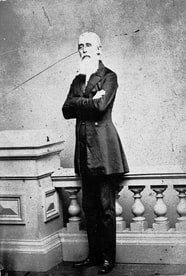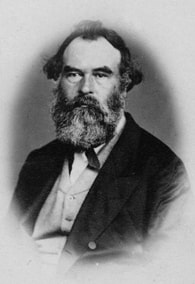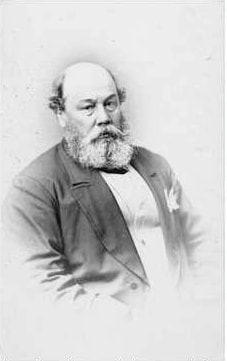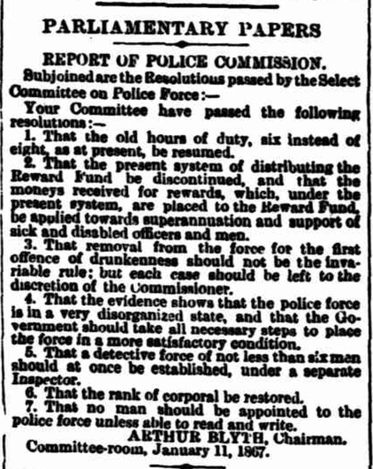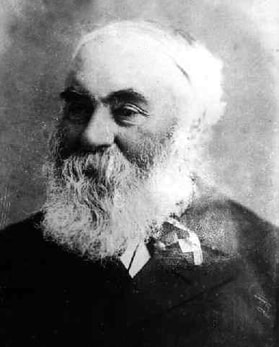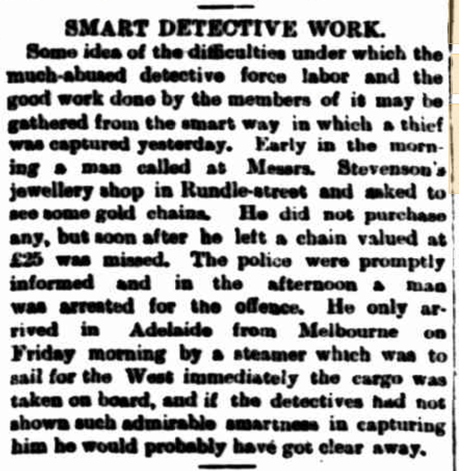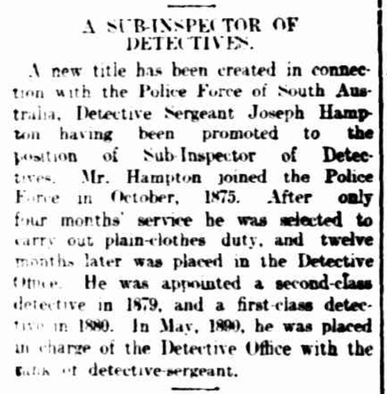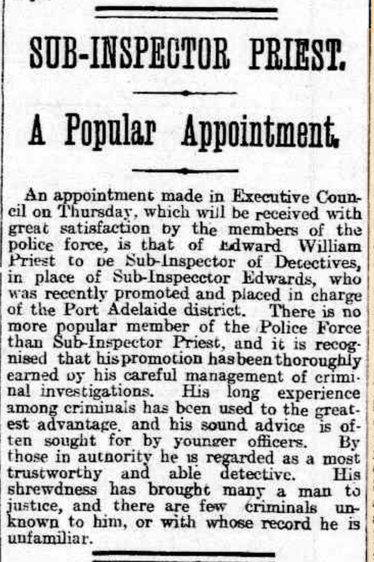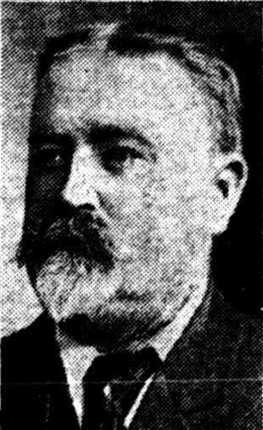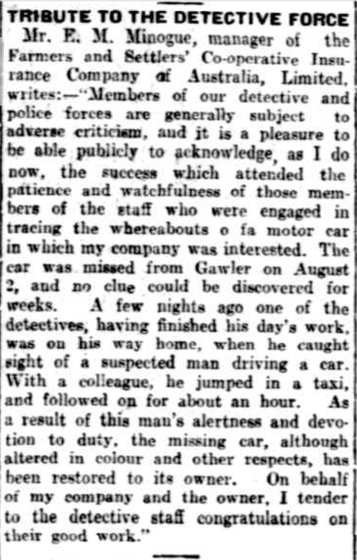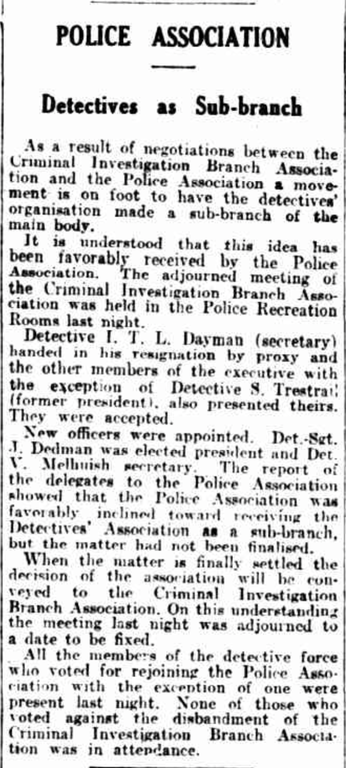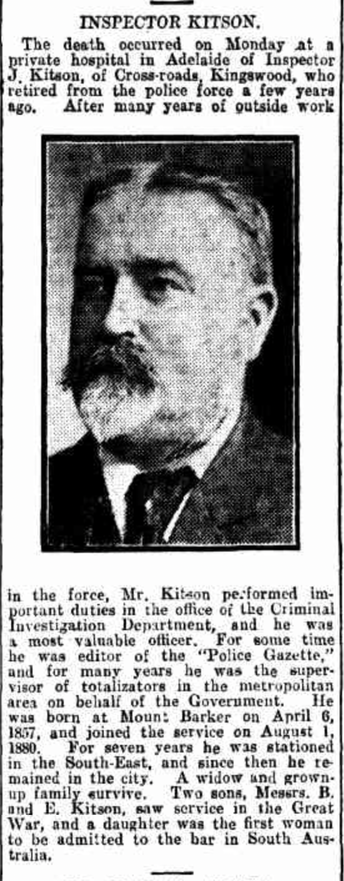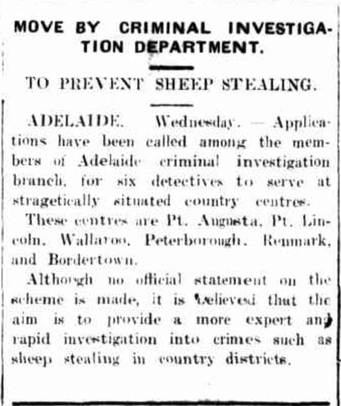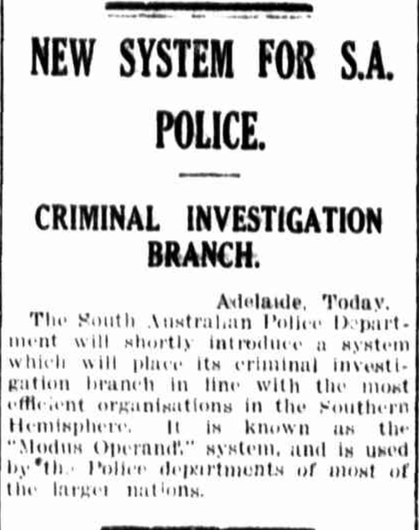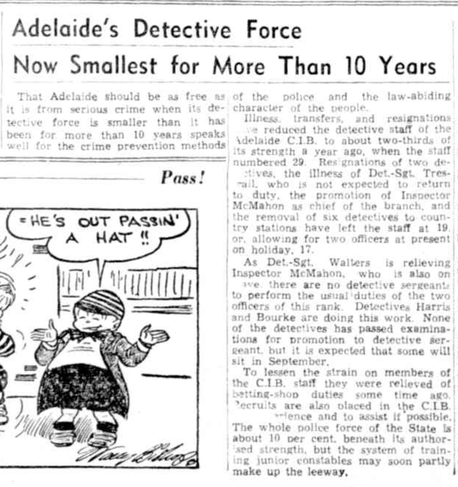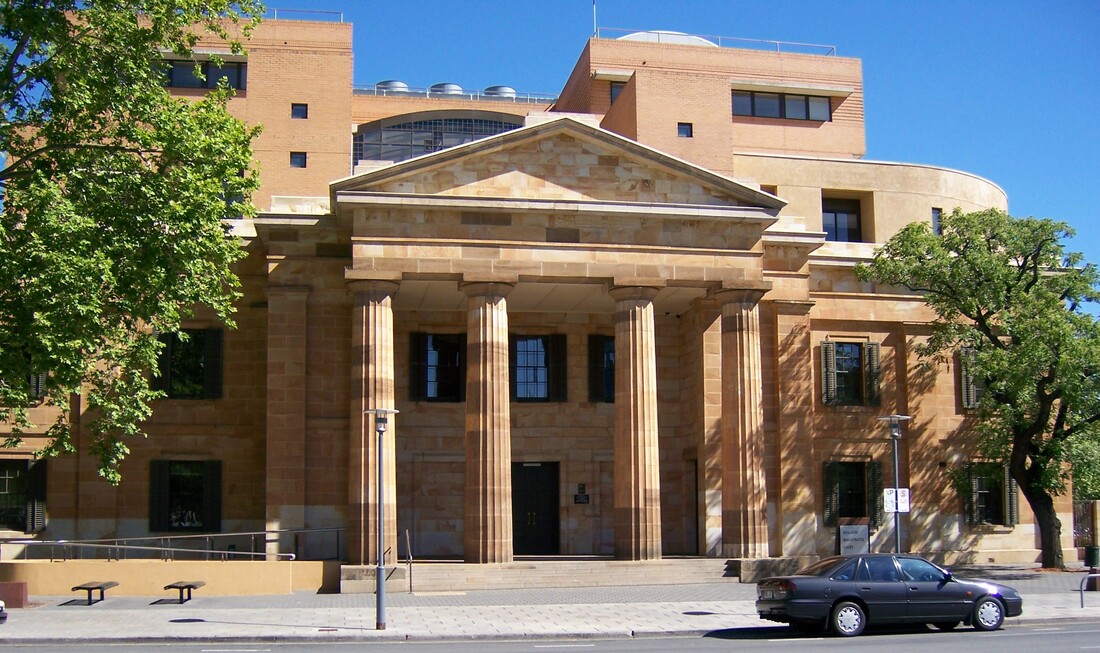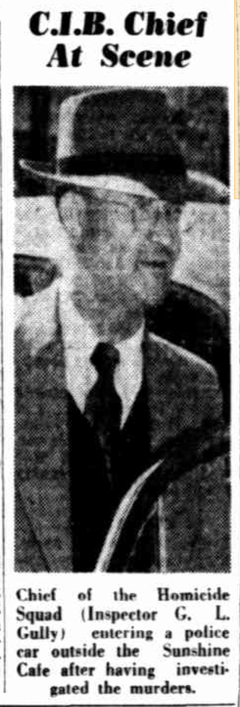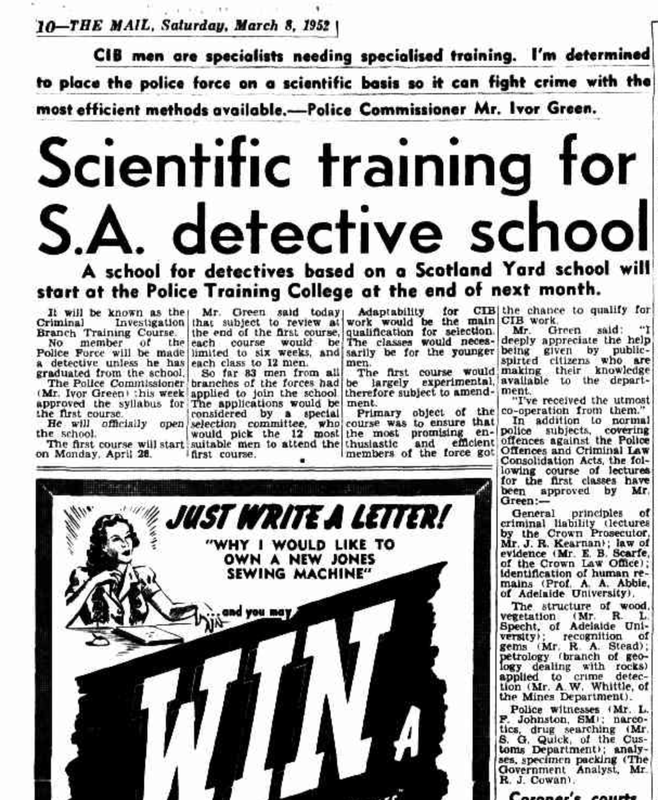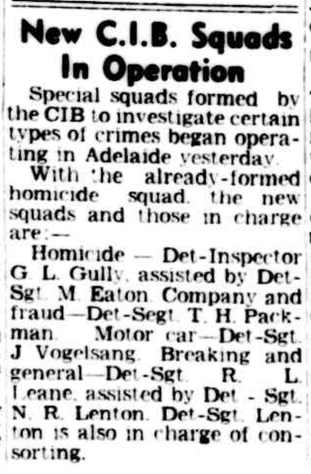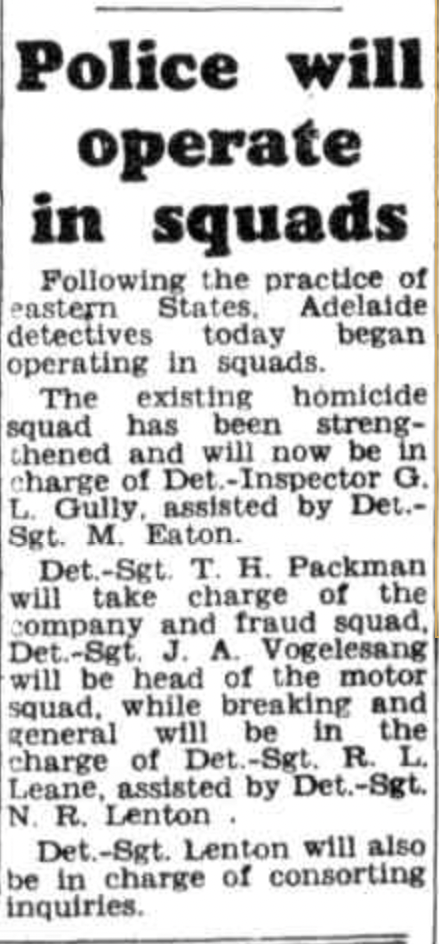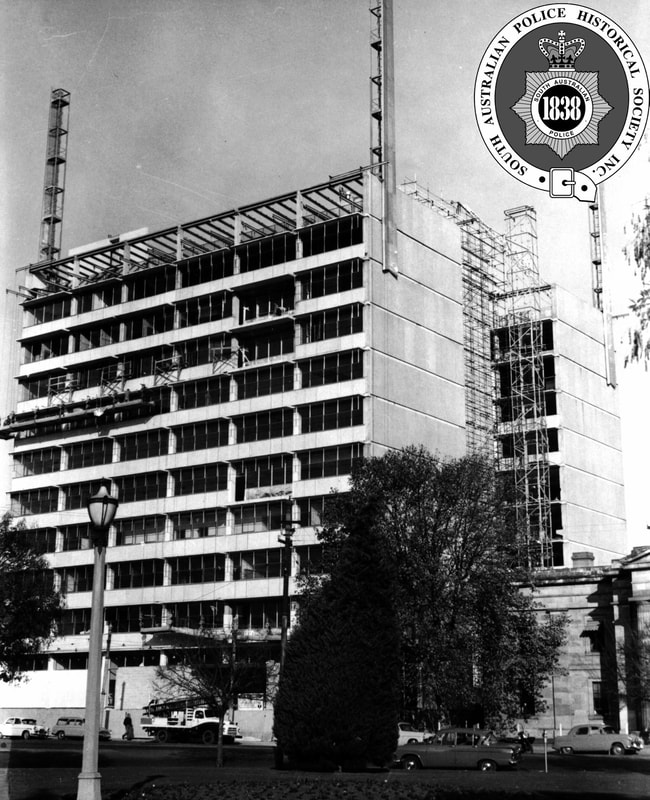THIS PAGE IS UNDER CONSTRUCTION AND STILL BEING RESEARCHED/COMPLETED.
HISTORY OF DETECTIVES IN SOUTH AUSTRALIA.
Formation of the South Australia Police Force.
The colony of South Australia was proclaimed on the 28th day of December 1836.
The South Australian Police Force is the oldest centrally controlled police service in Australia and one of the oldest in the world. It was formed on the 28th day of April 1838, following concerns that 'felons' were entering the colony of South Australia from the neighbouring colonies.
At its formation the South Australia Police was under the command of Inspector Henry Inman, and comprised of 10 Mounted Constables and 10 Foot Constables.
South Australia's first official Police Commissioner was Thomas Shuldham O'Halloran who served from June 1840 until April 1843. This was followed by Boyle Travers Finniss who served from April 1843 until May 1847. George Frederick Dashwood then served as the third Police Commissioner from May 1847 until December 1851.
The South Australian Police Force is the oldest centrally controlled police service in Australia and one of the oldest in the world. It was formed on the 28th day of April 1838, following concerns that 'felons' were entering the colony of South Australia from the neighbouring colonies.
At its formation the South Australia Police was under the command of Inspector Henry Inman, and comprised of 10 Mounted Constables and 10 Foot Constables.
South Australia's first official Police Commissioner was Thomas Shuldham O'Halloran who served from June 1840 until April 1843. This was followed by Boyle Travers Finniss who served from April 1843 until May 1847. George Frederick Dashwood then served as the third Police Commissioner from May 1847 until December 1851.
Early days of Detectives in South Australia.
In January 1852 Alexander Tolmer became the fourth Commissioner of Police in South Australia's short history.
The South Australian Register, Friday 3rd June 1853, printed the 'Report of the Commissioner of Police'. This was a report submitted by Commissioner Tolmer to the Lieutenant- Governor. In the report Tolmer stated the following:
"In the nature of an experiment by which I might feel my way to a sounder system, I selected, some months back, two or three of the most efficient men of the Metropolitan Division to act as a Detective Force. I have now to state, that the results have been successful; several of the worst characters in the city and environs have thereby been brought to justice, and gangs broken up and hunted out of the colony. I do myself the honour to submit, therefore the expediency of placing a sum on the Estimates for the ensuing year, especially for this service. Should his Excellency approve of such a measure, I would respectfully beg to recommend that the detective branch should consist of two sergeants and six constables, who should be selected out of the whole force for this peculiar business, and be exempt from all regular duty, enabling them thereby to employ their time wholly in the actual pursuit of criminals, or in obtaining information as to facilities for the commission of particular offences, and the haunts and habits of the offenders. In this art depends much upon individual qualifications, sagacity in drawing inferences from slight things, fertility of resource, a blood-hound tenacity or pursuit, intimate acquaintance with the habit of thieves, and their probably mode of acting in particular circumstances, and in the knack of making a cast in the right direction in search of a clue".
1853 - Recommendation for Detective Police Force.
By mid 1853, Commissioner Tolmer had recommended to the Lieutenant-Governor to place a sum on the estimates for the employment of a Detective Police Force.
This branch of the Police would consist of two Sergeants, and six Constables whose 'time should be employed either in the actual pursuit of criminals, or in obtaining information as to the habits and haunts of offenders'.
This branch of the Police would consist of two Sergeants, and six Constables whose 'time should be employed either in the actual pursuit of criminals, or in obtaining information as to the habits and haunts of offenders'.
Above:- Article from the Adelaide Times Sat 4 Jun 1853. c/o Trove
1853 - Establishment of a Detective Branch.
Tolmer succeeded in the creation of a Detective Branch.
By November 1853, a new Police Commissioner had been appointed, Peter Egerton Warbuton.
Alexander Tolmer had been dismissed and demoted to the rank of Inspector.
By November 1853, a new Police Commissioner had been appointed, Peter Egerton Warbuton.
Alexander Tolmer had been dismissed and demoted to the rank of Inspector.
Commissioner Warburton allowed the Detective Branch to continue. It consisted of two Sergeants and six Constables, under the command of Inspector Tolmer.
In the Police Commissioners Quarterly Report in April 1854, Commissioner Warburton stated the following:
"The Metropolitan Police has been brought up to its allowed strength, and sufficiently drilled to move in an orderly and compact manner, by the exertions of Inspector Reid; and the establishment of a detective branch under two sergeants has added to the efficiency of Mr. Reid's force. I am, however, doubtful whether a fixed detective establishment is at present the best system that could be adopted. I should prefer that, when cases calling for peculiar activity and intelligence arise, the requisite number of picked men (whether mounted for foot police) should be employed, giving them, as a present, a shilling a day extra during the period of such employment. I think this plan would not only be more economical, but would keep alive a higher spirit of emulation throughout the whole force, and on both points the public would be the gainers. When the present system has had a longer trial, I shall revert to the subject."
"The Metropolitan Police has been brought up to its allowed strength, and sufficiently drilled to move in an orderly and compact manner, by the exertions of Inspector Reid; and the establishment of a detective branch under two sergeants has added to the efficiency of Mr. Reid's force. I am, however, doubtful whether a fixed detective establishment is at present the best system that could be adopted. I should prefer that, when cases calling for peculiar activity and intelligence arise, the requisite number of picked men (whether mounted for foot police) should be employed, giving them, as a present, a shilling a day extra during the period of such employment. I think this plan would not only be more economical, but would keep alive a higher spirit of emulation throughout the whole force, and on both points the public would be the gainers. When the present system has had a longer trial, I shall revert to the subject."
The first South Australian Detective Sergeants.
It is believed that the first South Australian Detective Sergeants were Sergeant Richard Nolan and Sergeant Davis.
In 1854 Sergeant Nolan was mentioned for distinguished service in the Police Commissioner's Quarterly Report.
Unrest.
Unrest soon commenced between Foot Police and the Detectives.
The South Australian Register Friday 1st February 1867 reported:-
"Up to this time, it appears there had been men kept exclusively for detective duties, but this led to jealousy, and, what was worse, it led also to the establishment of a dangerous power in the hands of some members for the force. The detectives became an imperium in imperio, a body of men who collected information, and then exercised their own will as to what part of it they should divulge. The Commissioner says there was a withholding of information, so that the detectives became an injury rather than a benefit to the public service. He therefore abolished then altogether, and adopted the rough and ready plan of making every man a detective when circumstances required it"
The South Australian Register Friday 1st February 1867 reported:-
"Up to this time, it appears there had been men kept exclusively for detective duties, but this led to jealousy, and, what was worse, it led also to the establishment of a dangerous power in the hands of some members for the force. The detectives became an imperium in imperio, a body of men who collected information, and then exercised their own will as to what part of it they should divulge. The Commissioner says there was a withholding of information, so that the detectives became an injury rather than a benefit to the public service. He therefore abolished then altogether, and adopted the rough and ready plan of making every man a detective when circumstances required it"
1866 - Select Committee.
In 1866 a Select Committee of the Legislative Council was established and was chaired by Chief Secretary Arthur Blyth.
The Committee tabled its report in January 1867. One of the recommendations was the establishment of a 6 man 'detective force' under the command of an Inspector.
Above:- Article from the Adelaide Observer, Sat 19 Jan 1867. c/o Trove
1867 - Re-establishment of the Detective Force.
Following the Select Committee on the Police Force, the Detectives Force was re-established by then Police Commissioner Hamilton. He established an office which comprised an Inspector and five Detectives.
Richard Dempsey was appointed as the first Detective Clerk. He divided the Adelaide metropolitan area into distinct Detective Divisions with one Detective appointed to each Division in which he would reside.
Each Detective was required to compile a special file which listed every house with details of the occupants and any 'special remarks'. This was to ensure that Detectives had intimate knowledge of persons in their area.
Each Detective was required to compile a special file which listed every house with details of the occupants and any 'special remarks'. This was to ensure that Detectives had intimate knowledge of persons in their area.
Members of the community saw this as an intrusion of their privacy and as a result Commissioner Hamilton cautioned the Detectives not to annoy the public unduly as this may result in a loss of support and the loss of valuable information.
One woman complained that when visited by the Detectives, they remained at her home for considerable time drinking alcohol.
Another member of the public complained that the Detectives had threatened her landlord when she refused to help with their enquiries.
Other allegations included that the Detectives were accepting bribes, and performing domestic and private espionage on behalf of people outside of the police department.
One woman complained that when visited by the Detectives, they remained at her home for considerable time drinking alcohol.
Another member of the public complained that the Detectives had threatened her landlord when she refused to help with their enquiries.
Other allegations included that the Detectives were accepting bribes, and performing domestic and private espionage on behalf of people outside of the police department.
Detective Force office.
The Detective Force was located in a small building in Gilbert Place, Adelaide. It was rented from a Hindley Street confectioner.
The South Australian Register of Wednesday 22nd January 1868 described the office:
"In a snug corner of Gilbert Place, with a very convenient access into the busy thoroughfare of Hindley-street, there is a small office, whose character would be little suspected by the casual passer-by. The door always stands invitingly open, like that of a commission agent in his first year of probation. The internal appearance and fittings of the room are neat, indicating a successful adaptation of upholstery to business. Everything is so sedate and respectable that the last place in the world one would suppose it to be is a house of call for Bow-street runners. And yet that is its function. It is the office of the new Detective Force established by Mr. Commissioner Hamilton about a year ago".
"In a snug corner of Gilbert Place, with a very convenient access into the busy thoroughfare of Hindley-street, there is a small office, whose character would be little suspected by the casual passer-by. The door always stands invitingly open, like that of a commission agent in his first year of probation. The internal appearance and fittings of the room are neat, indicating a successful adaptation of upholstery to business. Everything is so sedate and respectable that the last place in the world one would suppose it to be is a house of call for Bow-street runners. And yet that is its function. It is the office of the new Detective Force established by Mr. Commissioner Hamilton about a year ago".
Upon a crime being reported, the particulars were recorded by the constable, troooper, or officer in charge. The form set forth the nature and locality of the offence, the date and
1869 - Disbandment of Detectives
In 1869 the South Australian government ordered retrenchments in police strength. This resulted in Detectives being removed from Government Estimates and being returned to normal duties.
In the Police Commissioner's Report of June 1869, Commissioner Hamilton reported to the Government:
"During the quarter the separate detective force was merged into the Metropolitan Police.........The Metropolitan Inspector also reports well of the conduct of the police under him, and especially that of the constables told off for detective duty."
In the Police Commissioner's Report of June 1869, Commissioner Hamilton reported to the Government:
"During the quarter the separate detective force was merged into the Metropolitan Police.........The Metropolitan Inspector also reports well of the conduct of the police under him, and especially that of the constables told off for detective duty."
1875 - Reformation of the Detective Branch.
The Detective Branch was not reformed until 1875 at which time it was placed under the command of Inspector William Peterswald.
In 1878 Peterswald was appointed to the rank of Superintendent of Detectives and Commissioner Hamilton's Deputy. By 1882 Peterswald was appointed as Commissioner of Police.
In 1878 Peterswald was appointed to the rank of Superintendent of Detectives and Commissioner Hamilton's Deputy. By 1882 Peterswald was appointed as Commissioner of Police.
Above:- William John Peterswald. Image c/o Wikipedia.
In 1875 the South Australia Police consisted of the following:-
- 1 Commissioner
- 3 clerks
- 6 Inspectors (1 of the metropolitan police and 4 of the mounted police and 1 in the Northern Territory)
- 1 Sergeant Major in the Mounted Police
- 11 Sergeants (1 Detective, 5 Metropolitan, 1 Port & Water Police, 4 Mounted, 1 Northern Territory)
- 14 Corporals
- 1 saddler
- 202 Constables (of whom 6 were Detectives)
- 2 female searchers
- 248 horses
1881.
In 1881 still referred to as Detective Force.
1897.
Above: Article from The Advertiser, Sat 17 Jul 1897. c/o Trove
1899.
Above: Article from The Sydney Morning Herald, Thurs 30th November 1899. Image c/o Trove
1899 - a new title created.
In January 1899 a new title was created within the South Australia Police Force, that of Sub Inspector of Detectives. The first officer to fill this role was Detective Sergeant Joseph Hampton who joined the Police Force in October 1875. He had only served for four months before being selected to carry out plain clothes duty. Twelve months later he was placed in the Detective Office.
Above:- Article from the South Australian Register, Fri 27 Jan 1899. Image c/o Ttrove
1900.
Above:- Article from The Age Melbourne, Sat 20 Jan 1900. Image c/o Trove
At the end of January 1900 the South Australian Government adopted the recommendations of the Police board which viewed the offences referred to them as 'trivial' regarding the suspended Detectives.
1903 - a new Sub Inspector of Detectives.
In 1903 the Executive Council appointed Mr. Thomas Edwards to be the Sub-Inspector of detectives, in succession to the late Sub-Inspector Upton.
Above: Sub Inspector Edwards. Image c/o Adelaide Observer, Sat 15 Aug 1903, Trove
Edwards was born in 1853 aboard the Neptune whilst in the Great Australian Bight, while his parents were voyaging from Cornwall to Australia.
The Edwards family first resided at Kapunda and Burra before moving to the Wallaroo Mines. At the age of eight, Edwards worked at the picking table, then in the store, and eventually with his father underground.
At age thirteen he attended a night school at Kadina.
In 1875 Edwards offered his services as a Constable, and in April 1876 he was accepted into the Police Force. He resigned but rejoined in August 1877. In 1882 he was placed in the plainclothes office and he was chosen to do 'tailing' work - tracking after suspects.
In 1888 he entered the service of the General Post Office as a First Class Detective. By 1892 he had returned to the Detective Office.
Edwards was involved in a number of high profile murder cases. He was also the Officer in Charge of the notorious 1902 Block 14 daylight robbery case. A number of masked men on horseback bailed up a cab containing mining officers who had drawn from the bank at Port Adelaide, over a thousand pounds to pay the wages of employees.
The Edwards family first resided at Kapunda and Burra before moving to the Wallaroo Mines. At the age of eight, Edwards worked at the picking table, then in the store, and eventually with his father underground.
At age thirteen he attended a night school at Kadina.
In 1875 Edwards offered his services as a Constable, and in April 1876 he was accepted into the Police Force. He resigned but rejoined in August 1877. In 1882 he was placed in the plainclothes office and he was chosen to do 'tailing' work - tracking after suspects.
In 1888 he entered the service of the General Post Office as a First Class Detective. By 1892 he had returned to the Detective Office.
Edwards was involved in a number of high profile murder cases. He was also the Officer in Charge of the notorious 1902 Block 14 daylight robbery case. A number of masked men on horseback bailed up a cab containing mining officers who had drawn from the bank at Port Adelaide, over a thousand pounds to pay the wages of employees.
Above: Article from The Narracoorte Herald, Fri 24 Jan 1902
1905 - a new Sub Inspector of Detectives.
Edward William Priest was appointed the new Sub Inspector of Detectives, replacing Sub Inspector Edwards who had been promoted and placed in charge of the Port Adelaide district.
Above: Article from The Express and Telegraph, Thu 26 Jan 1i905. Image c/o Trove
1916 - a new Sub Inspector of Detectives.
Detective Sergeant John Kitson was appointed to be Sub Inspector of Detectives. Kitson was born in Mount Barker in April 1857 and joined the Police Force on 1st August 1880. He was promoted to the rank of Detective Sergeant in 1907.
Sub Inspector Thomas Edwards was appointed as Commissioner of Police.
Sub Inspector Thomas Edwards was appointed as Commissioner of Police.
Above:- Detective Sergeant Kitson. Image c/o Trove
1920 Kitson retires and a new Sub Inspector appointed.
In July 1920, Sub Inspector Kitson retired.
His successor was Sub Inspector J. O'Sullivan.
His successor was Sub Inspector J. O'Sullivan.
Above: Article from the Critic, Adelaide, Wed 14 Jul 1920. Image c/o Trove
1920s - Criminal Investigation Department.
During the early 1920s the Detective Force was referred to as the Criminal Investigation Department.
In 1922 four more Detectives were appointed to the staff of the Criminal Investigation Department. This boosted the number of Detectives in the Department following the depletion of the Department following the promotion of several members to commissioned rank.
Above:- Article from The Register, Adelaide, Fri 26 Sep 1924. c/o Trove
1922 - Sub Inspector Whittle appointed.
In 1923 Harold Edgar Whittle was appointed Sub Inspector of Detectives.
1923 - No more Sub Inspectors.
Above:- Article from the Chronicle, Adelaide, Sat 30 Jun 1923. Image c/o Trove
1925 - Annual Dinner of the Criminal Investigation Branch Association.
The first annual dinner of the Criminal Investigation Branch Association of South Australia was held in December 1925. The dinner was held in the presence of leading members of the business, legal, and medical professions.
Mr. M. J. Hogan, Chairman of Stpendiary Stewards who was a guest at the dinner, stated:
"Few people are aware of the multifarious duties which devolve upon a detective".
Mr. M. J. Hogan, Chairman of Stpendiary Stewards who was a guest at the dinner, stated:
"Few people are aware of the multifarious duties which devolve upon a detective".
1927 - Detectives as a Sub-branch of the Police Association.
Above:- Article from the News Adelaide, Tues 31 May 1927. c/o Trove.
1928 - Officers added to Detective Branch.
In 1928 due to increased work and extra leave granted to police officers, four police officers were added to the Detective Branch.
1928 - Death of Inspector Kitson.
Above: Article from the Chronicle, Adelaide, Sat 16 Jun 1928. Image c/o Trove.
1930 - Efficient Detective Force.
Brig-General R.L. Leane, the Commissioner of Police stated that serious crime in South Australia was not increasing was attributed to an efficient detective force.
1935 - Sheep stealing specialists.
In April 1935 applications were called among members of the Adelaide Criminal Investigation Branch, for six Detectives to serve at country centres at Port Augusta, Port Lincoln, Wallaroo, Peterborough, Renmark, and Bordertown, to investigate sheep stealing.
Above: Article from the West Coast Sentinel Fri 6 April 1935. c/o Trove.
1935 - Introduction of the Modus Operandi system.
In mid 1935 the South Australian Police Department introduced the 'Modus Operandi' system to bring it into line with other Police Departments in the southern hemisphere.
Above:- Article from the Border Watch, Sat 20 Jul 1935. c/o Trove.
1935 - Detectives for country positions
In April 1935 applications were called among members of the Adelaide Criminal Investigation Branch for six Detectives to serve at country centres of Port Augusta, Port Lincoln, Wallaroo, Peterborough, Renmark, and Bordertown.
The Border Chronicle Bordertown reported that the aim was 'to provide more rapid investigations of crime, such as sheep stealing in country districts".
The Border Chronicle Bordertown reported that the aim was 'to provide more rapid investigations of crime, such as sheep stealing in country districts".
Above:- Article from the Border Chronicle Bordertown, Fri 12 Apr 1935.
Above:- Article from The News, Tues 25 Jun 1935. c/o Trove
1936 - Low numbers in Detective Force.
Above:- Article from the News, Adelaide, Thu 7 May 1936. c/o Trove
1950s.
During the 1950s the Criminal Investigation Branch was located on the first floor of the Magistrates Court building located at 1 Angas Street, Adelaide.
Above:- Adelaide Magistrates Court, 1 Angas Street, Adelaide. Image c/o Scott W, Wikipedia.
1951 - Creation of the Homicide Squad.
In 1951 the very first squad was formed in South Australia, the Homicide Squad. It came under the command of Detective Inspector Gully.
Above:- Article from The Advertiser, Mon 13 Apr 1953. c/o Trove
1951 - Proposal for Detective training.
In November 1951, Police Commissioner Ivor Green, announced that a departmental committee had been working on details of a special syllabus for Detective and CIB traning.
Above: Commissioner Green. Image c/o anglicancemeteries.com
Green stated that young police officers who desired would need to undertake the instructional course for entry to the C.I.B. The course was to be known as the Criminal Investigation Branch Training Course.
Above: Article from the News, Adelaide, Tues 27 Nov 1951. c/o Trove
Above: Article from The Mail, Adelaide, Sat 8 March 1952. c/o Trove
1952 - First Detective Training course.
The first Detective Training course in South Australia was conducted in 1952. A total of twelve police officers attended the six week course which commenced on the 28th day of April.
A Selection Committee chose 12 men for the first course from 83 applications received from all branches of the Force.
A Selection Committee chose 12 men for the first course from 83 applications received from all branches of the Force.
Above: Article from The Advertiser, Mon 10 Mar 1952. c/o Trove.
1952 - Establishment of Squads.
During the early 1950s a number of specialised Squads were formed. The Advertiser Friday 18th July 1952 reported that the squads had not been previously been required as 'specialised crime had been less prevalent".
Above: Article from The Advertiser, Fri 18 July 1952. c/o Trove
The first to be formed was the the Homicide Squad. This was followed in July 1952 by the Breaking Squad, General Squad, Company & Fraud Squad, and the Motor Squad.
Above: Article from The Advertiser, Fri 19 May 1950. c/o Trove
1960s.
In 1965 a multi storey building was constructed in Angas Street, Adelaide, alongside of the Magistrates Court.
References.
- Colonial Blue
- South Australia Police, 2022, <www.police.sa.gov.au/>
- South Australia Police Historical Society, 2022, <southaustralianpolicehistoricalsociety.com/learn/>
- Trove, 2022, Adelaide Times, Sat 3 Jun 1853
- Trove, 2022, South Australian Register Fri 3 Jun 1853
- Trove, 2022, Adelaide Observer Sat 6 May 1854
- Trove, 2022, South Australian Register, Wed 2 Jan 1868
- Trove, 2022, South Australian Register, Fri 27 Jan 1899
- Trove, 2022, South Australian Register, Tue 30 Jan 1900
- Trove, 2022, The Express and Telegraph, Adelaide, Wed 5 Aug 1903
- Trove, 2022, The Narracoorte Herald, Fri 23 Jun 1916
- Trove, 2022, Southern Cross, Adelaide, Fro 30 Jun 1916
- Trove, 2022, Chronicle Adelaide, Sat 1 Jul 1916
- Trove, 2022, The Mail, Adelaide, Sat 26 Jun 1920
- Trove, 2022, Critic, Adelaide, Wed 14 Jul 1920
- Trove, 2022, The Advertiser, Tue 1 Aug 1922
- Trove, 2022, Chronicle, Adelaide, Sat 30 Jun 1923
- Trove, 2022, News Adelaide, Tues 15 Dec 1925
- Trove, 2022, Chronicle, Adelaide, Sat 16 Jun 1928
- Trove, 2022, Recorder Port Pirie, Fri 31 Aug 1928
- Trove, 2022, News, Adelaide, Tues 27 Nov 1951.
- Trove, 2022, The Mail Adelaide Sat 8 Mar 1952
- Trove, 2022, The Adveertiser Mon 10 Mar 1952
- Trove, 2022, The Advertiser, Fri 18 Jul 1952

